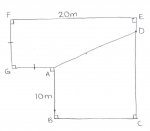Courtneydb
New member
- Joined
- Oct 1, 2011
- Messages
- 4
First off, I'm not sure which section of the forum these questions should be in, or even if they should be in the same section, but I took my best guess, sorry if I'm wrong. 
1. Solve for x and y. Both variables must satisfy the equation.
Part One: 3(3(x+2y)-2(x-2y)-y) = 81
I simplified it like this:
3(3x+6y-2x+4y-y) = 81
3(x+9y) = 81
Part Two: 9((2x+y)-(x+2y)) = 243
I simplified it like this:
9(2x+y-x-2y) = 243
9(x-y) = 243
I'm fairly sure that for this, I'm supposed to use elimination OR substitution, but if anyone can just explain to me a way to understand this, I'd really appreciate it. I don't need the answer, it's in the back of the textbook, but I really want to understand how to do this. I'm pretty lost at this point, I'm not sure where to go from here. Thanks
(By the way, if you want it, the answer is x=53/20 and y=3/20)
2. This question isn't from my textbook, so I don't have the answer, but I'd really appreciate help with it Here is the picture of the shape. I had to copy it down off the blackboard, so it IS NOT to scale. Side FG is equal to side GA. Side AB is 10m. Side FE is 20m. Line CD is the diagonal line in the middle.
Here is the picture of the shape. I had to copy it down off the blackboard, so it IS NOT to scale. Side FG is equal to side GA. Side AB is 10m. Side FE is 20m. Line CD is the diagonal line in the middle.

The total area is 280m2
the area of shape AGFED = the area of shape ABCD (so, 140m2)
What is the length of CD?
So far, I'm fairly lost with this question. I've tried a bunch of different ways, and I've also spoken to a lot of my classmates. Nobody has figured out what this is.
Thank you
1. Solve for x and y. Both variables must satisfy the equation.
Part One: 3(3(x+2y)-2(x-2y)-y) = 81
I simplified it like this:
3(3x+6y-2x+4y-y) = 81
3(x+9y) = 81
Part Two: 9((2x+y)-(x+2y)) = 243
I simplified it like this:
9(2x+y-x-2y) = 243
9(x-y) = 243
I'm fairly sure that for this, I'm supposed to use elimination OR substitution, but if anyone can just explain to me a way to understand this, I'd really appreciate it. I don't need the answer, it's in the back of the textbook, but I really want to understand how to do this. I'm pretty lost at this point, I'm not sure where to go from here. Thanks
(By the way, if you want it, the answer is x=53/20 and y=3/20)
2. This question isn't from my textbook, so I don't have the answer, but I'd really appreciate help with it

The total area is 280m2
the area of shape AGFED = the area of shape ABCD (so, 140m2)
What is the length of CD?
So far, I'm fairly lost with this question. I've tried a bunch of different ways, and I've also spoken to a lot of my classmates. Nobody has figured out what this is.
Thank you
